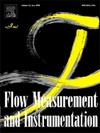通过横截面过渡结构实现无水跃变的超临界向亚临界的过渡
IF 2.3
3区 工程技术
Q2 ENGINEERING, MECHANICAL
引用次数: 0
摘要
激波使水工结构的设计复杂化,涉及到具有超临界流态的通道中的过渡。超临界流动特性的突然变化,例如在会聚过渡中,将导致与水力跃变相关的快速变化的流动,引起波浪和表面波动。因此,通过在通道内应用适当的过渡结构,可以消除液压跳变,并将这些干扰降至最低。在本研究中,通过分析/实验研究设计了一种截面过渡结构CSTS,消除了超临界来流弗劳德数在2.5 ~ 5.5之间的水力跳变。基于流体激波理论对过渡结构设计进行了分析研究,得出了排除超临界流型到亚临界流型的水力跳变的概念设计图。研究结果表明,目前的csts比相应的床层过渡结构bts效率更高,表明csts在不发生水力跳变的情况下从超临界流态转变为亚临界流态的潜力很大。利用本文的实验测量,对csts内部的流动进行了分析,并对分析结果进行了验证。根据实验观察,弱涡在临界段下游产生,在越过临界段的水自由面剖面下降后消失。本文章由计算机程序翻译,如有差异,请以英文原文为准。
Transition of super-to subcritical flow without a hydraulic jump by a cross-sectional transition structure
Shock waves complicate the design of hydraulic structures, involving the transitions in a channel with supercritical flow regime. Abrupt changes in characteristics of a supercritical flow, e.g., in convergent transitions, would result in a rapidly varied flow associated with a hydraulic jump, causing waves and surface fluctuations. Therefore, by applying an appropriate transition structure inside the channel, the hydraulic jump can be eliminated, and these disruptions are minimized. In the present study, an analytical/experimental investigation is conducted to design a cross-sectional transition structure CSTS, eliminating the hydraulic jump with supercritical inflow Froude numbers between 2.5 and 5.5. An analytical study was performed to design the transition structures based on the fluid shock waves theory, resulting in a conceptual design diagram for excluding the hydraulic jump from super-to subcritical flow regime. According to the results, the present CSTSs are more efficient than the corresponding bed transition structures BTSs, indicating great potential of the CSTSs to change the flow regime from super-to subcritical flow without a hydraulic jump. Flow inside the CSTSs was analyzed and the analytical results were verified, applying the present experimental measurements. Based on experimental observations, weak vortices are generated downstream of the critical section, disappearing after a fall in the water free-surface profile across the critical section.
求助全文
通过发布文献求助,成功后即可免费获取论文全文。
去求助
来源期刊

Flow Measurement and Instrumentation
工程技术-工程:机械
CiteScore
4.30
自引率
13.60%
发文量
123
审稿时长
6 months
期刊介绍:
Flow Measurement and Instrumentation is dedicated to disseminating the latest research results on all aspects of flow measurement, in both closed conduits and open channels. The design of flow measurement systems involves a wide variety of multidisciplinary activities including modelling the flow sensor, the fluid flow and the sensor/fluid interactions through the use of computation techniques; the development of advanced transducer systems and their associated signal processing and the laboratory and field assessment of the overall system under ideal and disturbed conditions.
FMI is the essential forum for critical information exchange, and contributions are particularly encouraged in the following areas of interest:
Modelling: the application of mathematical and computational modelling to the interaction of fluid dynamics with flowmeters, including flowmeter behaviour, improved flowmeter design and installation problems. Application of CAD/CAE techniques to flowmeter modelling are eligible.
Design and development: the detailed design of the flowmeter head and/or signal processing aspects of novel flowmeters. Emphasis is given to papers identifying new sensor configurations, multisensor flow measurement systems, non-intrusive flow metering techniques and the application of microelectronic techniques in smart or intelligent systems.
Calibration techniques: including descriptions of new or existing calibration facilities and techniques, calibration data from different flowmeter types, and calibration intercomparison data from different laboratories.
Installation effect data: dealing with the effects of non-ideal flow conditions on flowmeters. Papers combining a theoretical understanding of flowmeter behaviour with experimental work are particularly welcome.
 求助内容:
求助内容: 应助结果提醒方式:
应助结果提醒方式:


